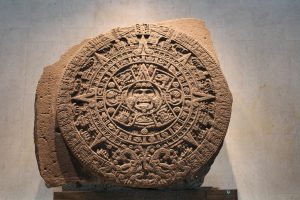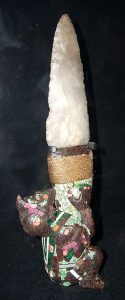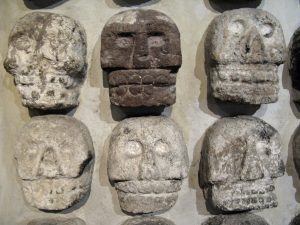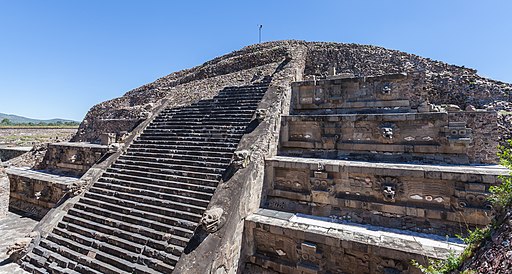Imagine being carried up stairs knowing its your last hour alive… How would you feel? What would you do? Well, for the Aztecs this was a common ritual. Human sacrifices were extremely important to the Aztecs and there are many reasons as to why they had sacrifices. The most common reason why they did this author Michel Graulich explains: “The usual explanations given by scholars are that the Aztecs wanted to propitiate their gods, to nourish them with the victims’ hearts, or to revitalize these deities by symbolically killing them.”1 Graulich offers another reason that is thought to explain why they had sacrifices: “The primary purpose of sacrifice…was ‘expiation of sins or transgressions in order to deserve a worthy afterlife.'”2 How did this process happen? Who was sacrificed? How did this ritual come to be?


Rituals were always important and were daily routines for the Aztecs. Every day, the Aztecs would hold a ceremony at a temple where they would offer a quail sacrifice so that they could make the sun rise. They had two calendars and both calendars were important: the ritualistic succession calendar marked certain days to celebrate the gods and to have festivals. The solar calendar contained eighteen months a year. The Aztecs were very cautious and they believed that anything that they did would be noticed by the gods. They sought to do everything that the gods asked of them, so that the gods would keep them from harm. Festivals were a part of the Aztecs’ daily life, and every day they would have some sort of event. Author Willard Booth states: “The special festivals of the day and month were governed by the ritual succession of days. Every special event required sacrifices. Special ceremonies governed the honoring of individuals and the investing of rank.”3 During these ceremonies/festivals, there were many gifts that were put forward to the gods and the Aztecs would offer feathers, food, wood, fire, animal feet. Another way people would give to the gods was through human blood, and the most common way for people to give blood was in “auto sacrifice.” Many of them would pierce their tongues or they would cut their own throat to let blood flow. Everyone was involved in the auto sacrifice, including children, women, and especially men. All needed to give blood. After children were born, they would be taken to a temple called Tlaloc and they would be blessed there; little girls would get their blood drawn from the ear lobes and little boys would get their blood drawn from the “virile member.” For men and women, blood-letting was totally different. They needed to draw blood from their thighs, upper arms, tongues, and even genitals. They would do this by using maguey thorns. This type of self-mutilation was one of the most common ways they would give blood to the gods, but human sacrifice was the most sacred forms of blood-letting. Many people were sacrificed: some volunteered, some were slaves, and some were children; but the most frequent form of human sacrifice came from prisoners of war.4 Let’s look at the process of sacrifice for a prisoner of war using a fictional character. I will call this prisoner “Miguel.”
Miguel was captured, and the one who captured him said, “He is as my beloved son,” and Miguel replied, “He is as my beloved father.” At that moment, Miguel would accept his destiny and he knew that he would die. There would be three steps that the Aztecs would followed during the festivals. The first step was “The Incarnation,” which was the beginning of the sacrifice, and during this time, Miguel would be painted and dressed up as the god that they were going to sacrifice him to. After that, there would be a waiting period, which could last up to a couple of days, months, or even years. During the waiting period, the community would take time to pay homage to Miguel, and they would consider him kind and respectable. Miguel would be paraded around, and there would be people dancing, singing, and overall just celebrating Miguel.5
The second step for Miguel was “The Sacrifice.” The beginning stages of the sacrifice were all different and it depended on how the victim reacted. There were different ways victims were taken to the top of the temple. Author Booth describes these different reactions of the victims: “Sometimes they were carried up in litters. Sometimes they were carried on the shoulders of the priests. In other sacrifices, depending on the amount of cooperation attained from the victim, they were dragged fighting and struggling or fainting with fear. At other times, they marched proudly up the three flights.”6 Since Miguel was captured and knew he was destined to die, he would walk up the stairs himself. He chose not to play the flute walking up the stairs, but other victims could choose to play the flute and break it while walking up the steps.
Continuing “The Sacrifice,” Miguel would see four to six priests standing there waiting for him. He would feel nervous, but at the same time ready to get it over with. Miguel would be taken by his arms and legs; they would bend him over backwards on a sacrificial stone known as the “Techcatl” and they would bow up his chest. The priest who would be preforming “The Price” would take the sacrificial knife and rip open a hole in the victim’s chest, and would stick his hand in and rip out the victim’s heart. Instantly, Miguel would die. There were many different ways to sacrifice someone, but the most common one was to present Miguel’s heart. The other ways included being set on fire, having arrows thrown at you, or being drowned; but the blood of the heart was the most crucial part of the ceremony. The magic substance that is within the blood and heart is called “Chakhihuatl.” After this, Miguel’s body would be rolled down the temple steps to scatter that magic substance.7
The last step is “The “Epiphany,” which would begin as soon as the body hits the ground. The bodies were thought to be reincarnated in different ways. Dismemberment and cannibalism was the most habitual way. Miguel’s head would get cut off and placed on a skull rack. Miguel’s body would get cut into multiple pieces, and his thigh would go to the emperor, and the rest of his body would go to whoever had captured him. Miguel’s arms and legs would be stewed with corn, and they would call it “Tlacatlolli.” They believed that by eating a victim, they would be soaking up the gods.8

The Aztecs had monthly sacrifices, and certain months would be dedicated to certain gods. Booth describes this: “The first, fourth, sixth, and sixteenth months were dedicated to the rain gods. Children, chosen because they had a circling double crown of hair, symbolizing whirlpools, were costumed as the rain gods and carried in a litter weeping to the sacrifice.9 The more they cried about being sacrificed, the more rain would fall. The rain gods helped grow the crops, but it was believed that when the rain gods were angry, they would cause droughts or floods.
In the second month, they would have a ceremony to Xipe totec, known as “Our Lord the Flayed One.” This ceremony would also extend into the third month. Xipe represented the start of spring and ending of winter. He also represented the triumph over skin diseases and illnesses. Warriors would wear the skin of Xipe and would impersonate him. They would sing throughout the night for a whole month. This month was also known for the scaffold sacrifice, which involved a male and a female: the female would be sacrificed at the altar, and the male would be tied to a scaffold and shot with arrows so that his blood would spill all over the ground. Both victims would release the magic that was thought to be in the blood.
Booth writes of this: “The fifth month was noteworthy for its extended impersonation and ritual. A special prisoner, chosen for his handsome appearance, was required to represent Tezcatlipoca, god of night, evil, and misery.”10 They would treat this prisoner like the incarnation of the god, and he would have an entourage with him and this would go on for a year. But during his last month, he would wear a battle dress and marry four wives, who would represent the four goddesses of providence. He would live with his wives for a month; then his wives and entourage would leave him. Then the day of the sacrifice would arrive, and he would walk up the steps of the temple by himself; and while was walking up the steps, he would break his flute; and when he was at the top of the stairs, his costume would be removed, and then the priests would rip his heart out.
Booth writes: “In four of the months, goddesses were impersonated, and women were sacrificed. The seventh month honored the goddess of salt, the eighth honored Xilonen, the goddess of tender corn, the eleventh honored the mother of gods, and the seventeenth honored ‘our mother’ Tonan.”11 The seventeenth month, as Patricia Anawalt writes, “Was Tititl, which featured the sacrifice of a middle-aged woman who impersonated the mother goddess Cihuacoatl.”12 It was crucial for the woman to weep to her death, and when she was sacrificed, she would be decapitated and her head would be placed on a receptacle and her head would be surrounded with paper rosettes. The next months were dedicated to the sun god. These months included the ninth, fourteenth, and fifteenth. This was a time when animals and weapons were blessed and there was a march and snake dance. During the ninth month, after the festival was over there was offering of flowers, and during the fourteenth month, a god named “Mixcoateopan” and his partner would get sacrificed. The eleventh month was also another time where women would be sacrificed but this one would be different. Young girls would be the ones sacrificed, and as Anawalt states, “a young girl was told she was to be honored with privilege of spending the night with the Emperor Moctezuma.”13 That in turn would not happen, and this young girl would have no idea what was to happen next. She would be dressed in a colorful outfit with tassels and she would then meet the priest who would lift her up and put her on his back. The worst was yet to come. While that happened, another priest would step forward as rapidly as he could and snap her neck. The fifteen month was just a mock battle. The tenth, twelfth, and eighteenth months were devoted to Xiuhtectuli (fire god), and during these months slaves were set on fire and then sacrificed. They were thrown into flames, and while they were on fire, their skin would burn and would start to peel. They got the victims out using hooks while they were alive, and then they were sacrificed. Lastly, “Nemontemi” were considered the worst days of the year and no events took place during those days.14
- Michel Graulich, “The Mystery of Aztec Sacrifice,” The Wilson Quarterly (1976-) 24, no. 4 (2000): 110. ↵
- Michel Graulich, “The Mystery of Aztec Sacrifice,” The Wilson Quarterly (1976-) 24, no. 4 (2000): 110. ↵
- Willard C. Booth, “Dramatic Aspects of Aztec Rituals,” Educational Theatre Journal 18, no. 4 (1966): 422. ↵
- Patricia R. Anawalt, “Understanding Aztec Human Sacrifice,” 35, no. 5 (1982): 44. ↵
- Willard C. Booth, “Dramatic Aspects of Aztec Rituals,” Educational Theatre Journal 18, no. 4 (1966): 423. ↵
- Willard C. Booth, “Dramatic Aspects of Aztec Rituals,” Educational Theatre Journal 18, no. 4 (1966): 423. ↵
- Willard C. Booth, “Dramatic Aspects of Aztec Rituals,” Educational Theatre Journal 18, no. 4 (1966): 423, 424. ↵
- Willard C. Booth, “Dramatic Aspects of Aztec Rituals,” Educational Theatre Journal 18, no. 4 (1966): 424; Patricia R. Anawalt, “Understanding Aztec Human Sacrifice,” Archaeology 35, no. 5 (1982): 44. ↵
- Willard C. Booth, “Dramatic Aspects of Aztec Rituals,” Educational Theatre Journal 18, no. 4 (1966): 424. ↵
- Willard C. Booth, “Dramatic Aspects of Aztec Rituals,” Educational Theatre Journal 18, no. 4 (1966): 425. ↵
- Willard C. Booth, “Dramatic Aspects of Aztec Rituals,” Educational Theatre Journal 18, no. 4 (1966): 425. ↵
- Patricia R. Anawalt, “Understanding Aztec Human Sacrifice,” Archaeology 35, no. 5 (1982): 44. ↵
- Patricia R. Anawalt, “Understanding Aztec Human Sacrifice,” Archaeology 35, no. 5 (1982): 44. ↵
- Patricia R. Anawalt, “Understanding Aztec Human Sacrifice,” Archaeology 35, no. 5 (1982): 44; Willard C. Booth, “Dramatic Aspects of Aztec Rituals,” Educational Theatre Journal 18, no. 4 (1966): 425. ↵



5 comments
Edwardo
Aztecs were evil. They not only sacrificed their enemies in battle, but also women and children. They practiced cannibalism as well. Any who thinks that the Aztecs were justified or or is covered by apologetics, because of there beliefs and lifestyle…. Needs to consider this: How would you feel if your neighbor started practicing the Aztec religion and decided that you and your family were to be chosen for the next sacrifice.
Fatima Esparza
Your article was very informative on the sacrifices that took place in the Aztec Empire. I really enjoyed reading about your example of the fictional character “Miguel” and how sacrifices work. Even though the Aztec people did not see these sacrifices as something bad, many others can argue that they were cruel. The different types of sacrifices mentioned sound incredibly painful, especially the one where they rip the person’s heart out.
Elliot Avigael
I was only aware of the “heart ritual” because of watching Mel Gibson’s Apocalypto, which was based roughly on Aztec culture (with some historical embellishment on Gibson’s part of course). I knew about certain bloodletting rituals as well but I was intrigued by the “flayed skin” practice and others you mentioned. I am a huge fan of ancient cultures and find the Aztecs to be one of the most interesting, so I found this to be a great read. Out of all pagan cultures and rituals I have studied, I have found Aztecs to be the most zealous.
Jacob Salinas
This was a great read! I enjoyed reading and learning more about the Aztecs. I learned that the Aztecs have a lot of traditions that are very important in their culture. One of the main rituals they performed were human sacrifices. These were important for the Aztecs in regard to giving sacrifices to their Gods they believe in. This was a daily occurrence that happened with the Atecs.
Adelina Wueste
Hello Ana, your article was very informative. When learning about the Aztecs we tend to learn about their participation in human sacrifice, but we don’t learn much about why they participated. I didn’t know that human sacrifices were not the only way that Aztecs sacrificed themselves to their gods. It was intriguing to learn that blood sacrifices, that did not lead to death, were done by just about every member of the community. I found it very interesting that every month Aztec communities held celebrations which included human sacrifice. I found it especially interesting that people were chosen for sacrifice because of certain characteristics that they had (like children who had a double crown of hair being chosen for rain god sacrifices).